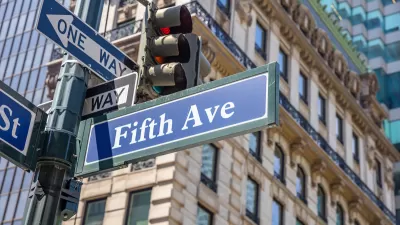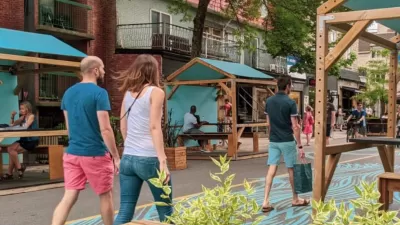Where pedestrian-only streets have failed to draw business, the problem may be a failure to think big enough.

The city of Buenos Aires has transformed a 20-lane congested highway into an 80-block multi-modal downtown avenue with dedicated bus lanes, plenty of space for walkers, and green space. Daily commute times have been cut in half for 200,000 bus passengers. Car access to these renovated streets is limited to local residents with parking passes. The speed limit for local car traffic is 10 km.
The Sustainable Mobility Plan for the city of nearly 3 million residents and 4 million commuters and tourists "rethinks the value and use of public spaces for citizens, not simply as areas reserved for transport services and connections, but as areas of mobility for citizens," according to the state's website.
Robert Everett-Green argues that similar attempts to pedestrianize streets in Canada have failed because they assumed that only highly commercial/retail zones would be appropriate for pedestrianization. A look at the Buenos Aires experience immediately exposes the weakness of most North American attempts at pedestrianization: that they are too narrowly focused on a few blocks of one street, with little thought given to the broader ecology of public space and transport," he writes. The head of transportation in Buenos Aires, Guillermo Dietrich "says the city was not swayed by the conventional wisdom that pedestrian zones only work in strong retail and nightlife zones," according to Everett-Green.
Everett-Green points out that pedestrian-only zones–such as a four-block stretch of Ottawa's Sparks Street–are too limited in scope. Adding planter boxes to a small zone where more than half the streetscape is populated by public works buildings is an insufficient strategy for appealing to pedestrians, he writes. In contrast, another 20 blocks are planned for the pedestrian-friendly zone on Avenida 9 de Julio in Buenos Aires, and spaces formerly used by parking lots are being repurposed for retail and residential development, suggesting that transit innovation can spur mixed use development.
FULL STORY: Walk this way: In Buenos Aires, pedestrian streets are the way of the future

Alabama: Trump Terminates Settlements for Black Communities Harmed By Raw Sewage
Trump deemed the landmark civil rights agreement “illegal DEI and environmental justice policy.”

Planetizen Federal Action Tracker
A weekly monitor of how Trump’s orders and actions are impacting planners and planning in America.

Why Should We Subsidize Public Transportation?
Many public transit agencies face financial stress due to rising costs, declining fare revenue, and declining subsidies. Transit advocates must provide a strong business case for increasing public transit funding.

Understanding Road Diets
An explainer from Momentum highlights the advantages of reducing vehicle lanes in favor of more bike, transit, and pedestrian infrastructure.

New California Law Regulates Warehouse Pollution
A new law tightens building and emissions regulations for large distribution warehouses to mitigate air pollution and traffic in surrounding communities.

Phoenix Announces Opening Date for Light Rail Extension
The South Central extension will connect South Phoenix to downtown and other major hubs starting on June 7.
Urban Design for Planners 1: Software Tools
This six-course series explores essential urban design concepts using open source software and equips planners with the tools they need to participate fully in the urban design process.
Planning for Universal Design
Learn the tools for implementing Universal Design in planning regulations.
Caltrans
Smith Gee Studio
Institute for Housing and Urban Development Studies (IHS)
City of Grandview
Harvard GSD Executive Education
Toledo-Lucas County Plan Commissions
Salt Lake City
NYU Wagner Graduate School of Public Service





























